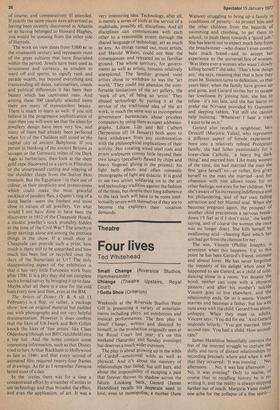Art
Sparklers
John McEwen
When the British Museum decides to mount a show gathered from its own collections and departments the result is rarely less than spectacular, and leaves one wondering why they ever feel the need to import foreign shows at all. The bibliography of the catalogue for their latest exhibition Jewellery Through 7,000 Years (till I February) alone stretches to five densely printed pages. Still, jewellery is magical, always has been, always will be and since this exhibition quite rightly concentrates on it as personal adornment it is best to forget the difference between such things as cloisonné and faience, Phoenician as opposed to the orientalised Greek style, and charge ahead with the eyes of a prospective buyer. This is a remarkable show, of course, and comparatively ill attended. If exactly the same pieces were advertised as having been recently discovered in Atlantis or as having belonged to Howard Hughes, you would be queuing from the other side of Harrods.
The work on view dates from 5,000 ac. to the nineteenth century and represents most of the great cultures that have flourished within the period. Jewels have been used as investment and currency, as amulets to ward off evil spirits, to signify rank and parade wealth, but beyond everything and transcending all dates, nationalities, creeds and political differences it has been their beauty which has captivated man. And among these 500 carefully selected items there are many of transcendent beauty. There is much to learn as well: if you still believe in the progressive sophistication of man then you will soon see that the ideas for jewellery design have been very few, and many of them had already been perfected when Ur of the Chaldees still stood as the capital city of ancient Babylonia. If you persist in thinking of the ancient Britons as savages or the Germanic tribes of the Dark Ages as barbarians, then look at the sheet gold cape discovered in a cairn in Flintsh ire or the unsurpassed cutting and inlaying of the shoulder clasps from the Sutton Hoo treasure. But the Egyptians—in their use of colour, in their simplicity and inventiveness which could make the most graceful necklace of pendent flies, a Queen's ring of a dung beetle—seem the freshest and most close to nature of all jewellers. Yet what would I not have done to have been the discoverer in 1912 of the Cheapside Hoard, a modest jeweller's stock probably hidden at the time of the Civil War? The amethyst drop earrings alone are among the prettiest things in the show. If a small shop in Cheapside can provide such a prize, how much is there still to be unearthed and how much has been lost or recycled since the days of the Sumerians at Ur? The only disappointing aspect of the exhibition is that it has very little European work from after 1700. It is a pity they did not complete such a broad survey by bringing it up to date. Maybe after all there is a case for the odd loan every now and then, even at the BM.
The Artists of Disney (V & A till 13 February) is a flop, or rather, a package show: low on original material but padded out with photographs and not very helpful documentation. However it does confirm that the likes of Ub lwerk and Bob Gillett knock the likes of 'fine artists' like Claes Oldenburg (though not Bill Crutchfield) into a top hat. And the notes contain some interesting information, such as that Disney tried to lure Arthur Rackham to Hollywood as late as 1946; and that every second of animated film required twenty-four frames of drawings. As far as I remember Fantasia lasted most of a day.
In the 'sixties there was for a time a concentrated effort by a number of artists to use technology and thus broaden the effect, and even the application, of art. It was a
very interesting idea. Technology, after all, is merely a series of tools at the service of a multitude, possibly all, disciplines. And all disciplines can communicate with each other to a reasonable extent through the shared language of technology, art as much as any. As things turned out, most artists, and Harold Wilson, could not bear the consequences and retreated on to familiar ground. The whole .territory, for governments as well as artists, remains relatively unexplored. Thefamiliar ground most artists chose to withdraw to was the 'art world.' They could not abandon the comfortable limitations of the art gallery, the 'work of art,' of being an 'artist.' They abused technology by putting it at the service of the traditional idea of the art work, in much the same way as incompetent government bureaucrats abuse priceless computers by using them as super addressographs. Liliane Lijn and Bill Culbert (Serpentine till 16 January) both seem to have withdrawn from any confrontation with the philosophical implications of their activity. Her rotating wired steel rods and prism sculptures convey little beyond their own luxury (peculiarly flawed by chips and heavy fingered gluing in the prisms); his light bulb effects and often romantic photographs of light are didactic. It is good to see two artists soldiering on in the art and technology tradition against the fashion of the times, but despite their long adherence to the task both will have to be more intellectually severe with themselves if they are to become the explorers their vocation demands.



































 Previous page
Previous page